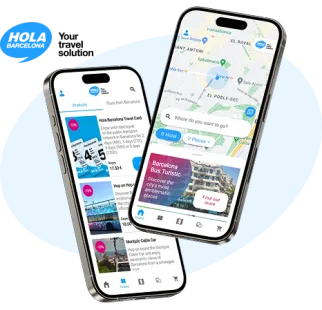Montjuïc Olympic Ring
The venues of the 1992 Olympic Games.
In the middle of Montjuïc Park, covering an approximate area of 400 hectares, we find the so-called Olympic Ring of Barcelona.
On this tour, you will discover the main sports facilities built or renovated for the Olympic and Paralympic Games of Barcelona '92.
In recent years, some of these spaces have been adapted to host sports and musical events, while others continue to be places where Barcelonians can enjoy sports.

Montjuïc Cable Car, on the Hola Barcelona app
Your app for discovering the city from the heights with the Montjuïc Cable Car: journey, stops and most iconic places. A comfortable way to carry your tickets too!
What to visit in the Olympic Ring?
Since Barcelona was chosen as the Olympic host city in 1986, it began a complete transformation. A countdown started, during which sports facilities were created throughout the city. Montjuïc became the nerve center.
- Lluís Companys Olympic Stadium: Built in 1929, it was completely remodeled for the Olympic and Paralympic Games of Barcelona '92, except for the facade. It was the venue for the opening and closing ceremonies. It has a capacity of 60,000 spectators.
- Palau Sant Jordi: Designed specifically for the Barcelona Olympics by Japanese architect Arata Isozaki, this pavilion hosted Olympic competitions in handball, gymnastics, and volleyball, as well as Paralympic events in table tennis and volleyball. Today, it is the epicenter of the most massive concerts held in Barcelona.
- Bernat Picornell Pools: Inaugurated in 1970, they were remodeled to host the swimming, synchronized swimming, and water polo competitions of Barcelona '92.
- Torre de Calatrava: Designed by architect and engineer Santiago Calatrava, this communications tower has become an undisputed symbol of Barcelona's skyline.
- INEFC Barcelona: Built by architect Ricard Bofill, this classical-style building houses one of the headquarters of the National Institute of Physical Education of Catalonia. In 1992, during the Olympic Games, it hosted the freestyle and Greco-Roman wrestling competitions, while in the Paralympic Games, it was the venue for wheelchair fencing and judo events.
- Joan Antoni Samaranch Olympic and Sports Museum: Inaugurated in 2007, it features interactive spaces with advanced technology about the history of sports in the city.
The Olympic Ring is surrounded by the Joan Maragall Gardens and the Botanical Garden, where you can take a break to enjoy the shade and vegetation.
For the curious ones
- In front of Palau Sant Jordi, you will find the artistic installation Utsurohi (Change) by Aiko Miyawaki, dedicated to movement and dynamism.
- Barcelona’s selection as the Olympic city also led to other innovations in the transformation of the city, such as the Olympic Port, the Olympic Village, and the reinforcement of the entire transport network with two additional terminals at El Prat airport and the creation of key links and roads such as Glòries, Ronda Litoral, and Ronda de Dalt.
- Entry to the Picornell Pools facilities is free and includes a bar service. It is the ideal place to take a break, have a bite, and contemplate the city from its grandstand.






